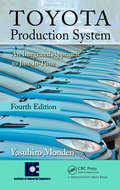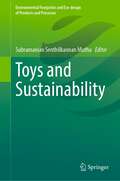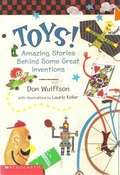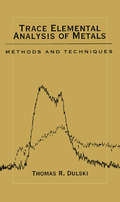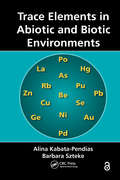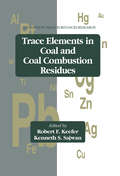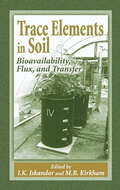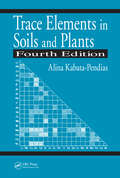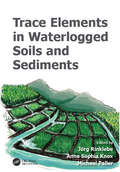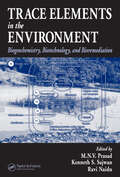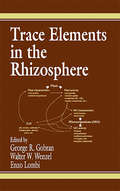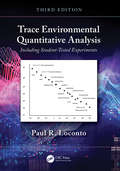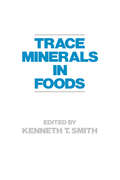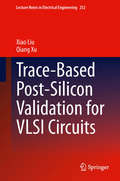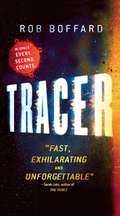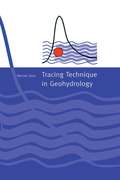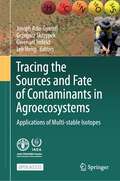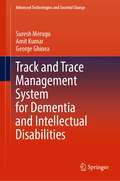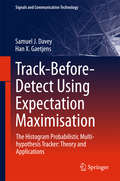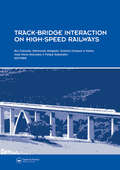- Table View
- List View
Toyota Production System: An Integrated Approach to Just-In-Time, 4th Edition
by Yasuhiro MondenA bestseller for almost three decades, Toyota Production System: An Integrated Approach to Just-In-Time supplies in-depth coverage of Toyota's production practices, including theoretical underpinnings and methods for implementation. Exploring the latest developments in the Toyota Production System (TPS) framework at Toyota, this new edition updates
Toys and Sustainability (Environmental Footprints and Eco-design of Products and Processes)
by Subramanian Senthilkannan MuthuThis book presents five interesting chapters dealing with the sustainability of toys. The concept of sustainability has reached all industrial sectors these days and being practiced in almost all the sectors. One of the main sectors where sustainability has to be embedded to the core is the toy sector. Needless to enumerate the importance of sustainability in this sector especially when it comes to usage of chemicals and so on. There are various elements associated with the sustainability of toys and there is a dearth of published literature on this subject.
Toys!: Amazing Stories Behind Some Great Inventions
by Don WulffsonDescribes the creation of a variety of toys and games, from seesaws to Silly Putty and toy soldiers to Trivial Pursuit. <P><P>[This text is listed as an example that meets Common Core Standards in English language arts in grades 4-5 at http://www.corestandards.org.]
Trace Elemental Analysis of Metals: Methods and Techniques
by Thomas R. DulskiThis work details minor, trace and ultratrace methods; addresses the essential stages that precede measurement; and highlights the measurement systems most likey to be used by the pragmatic analyst. It features key material on inclusion and phase isolation. The book is designed to provide useful maps and signposts for metals analysts who must verify that stringent trace level compositional specifications have been met.
Trace Elements in Abiotic and Biotic Environments
by Alina Kabata-Pendias Barbara SztekeThis book helps readers understand the fundamental principles and phenomena that control the transfer of trace elements. It describes the occurrence and behavior of trace elements in rocks, soil, water, air, and plants, and also discusses the anthropogenic impact to the environment. In addition, the book covers the presence of trace elements in feeds, as either contaminants or as nutritional or zootechnical additives, and their transfer across the food chain to humans. All trace elements are covered-from aluminum to zirconium-as well as rare-earth elements (actinides and lanthanides).
Trace Elements in Coal and Coal Combustion Residues (Advances In Trace Substances Research Ser. #5)
by Robert F. Keefer Kenneth S. SajwanTrace Elements in Coal and Coal Combustion Residues focuses on trace metal chemistry of coal and coal combustion residues. Special emphasis is placed on management of coal combustion residues in electric power plants and the influence of coal and associated residues on soils, plants, water, and animals. Topics covered include a brief summary of research sponsored by Electric Power Research Institute, environmental pollution from coal combustion plants in low-rainfall regions, accumulation of trace elements in freshwater mussels near a power plant, testing to evaluate fossil fuel wastes by chemicals and isotopes, transport of metals from coal piles and ash impoundments, leachability and toxicity of metals in fly ash, and plant absorption of chemicals from ash. The book will be a useful reference for environmental and reclamation consultants, environmental engineers, toxicologists, environmental regulatory personnel, officials with electric power utilities and water treatment plants, and soil scientists.
Trace Elements in Soil: Bioavailability, Flux, and Transfer
by M. B. Kirkham I. K. IskandarHistorically, research on the methods and amounts of trace element application to agriculture soils for correcting plant deficiencies has received major attention. More recently, due to industrial development and past disposal activities, trace elements are considered to be important environmental contaminants that affect all components in the atmo
Trace Elements in Soils and Plants
by Alina Kabata-PendiasStill the Gold Standard Resource on Trace Elements and Metals in SoilsThis highly anticipated fourth edition of the bestselling Trace Elements in Soils and Plants reflects the explosion of research during the past decade regarding the presence and actions of trace elements in the soil-plant environment. The book provides information on the biogeoch
Trace Elements in Waterlogged Soils and Sediments (Advances in Trace Elements in the Environment #3)
by Michael Paller Anna Sophia KnoxMany wetlands around the world act as sinks for pollutants, in particular for trace elements. In comparison to terrestrial environments, wetlands are still far less studied. A collaborative effort among world experts, this book brings the current knowledge concerning trace elements in temporary waterlogged soils and sediments together. It discusses factors controlling the dynamics and release kinetics of trace elements and their underlying biogeochemical processes. It also discusses current technologies for remediating sites contaminated with trace metals, and the role of bioavailability in risk assessment and regulatory decision making. This book is intended for professionals around the world in disciplines related to contaminant bioavailability in aquatic organisms, contaminant fate and transport, remediation technologies, and risk assessment of aquatic and wetland ecosystems.
Trace Elements in the Environment: Biogeochemistry, Biotechnology, and Bioremediation
by M.N.V. Prasad Ravi Naidu Kenneth S. SajwanNew analytical techniques have enhanced current understanding of the behavior of trace and ultratrace elements in the biogeochemical cycling, chemical speciation, bioavailability, bioaccumulation, and as applied to the phytoremediation of contaminated soils. Addressing worldwide regulatory, scientific, and environmental issues, Trace Elements in th
Trace Elements in the Rhizosphere
by George R. Gobran Walter W. Wenzel Enzo LombiThe first book devoted to the complex interactions between trace elements, soils, plants, and microorganisms in the rhizosphere, Trace Elements in the Rhizosphere brings together the experimental, investigative, and modeling branches of rhizosphere research. Written by an international team of authors, it provides a comprehensive overview of the me
Trace Environmental Quantitative Analysis: Including Student-Tested Experiments
by Paul R. LocontoA thorough and timely update, this new edition presents principles, techniques, and applications in this sub-discipline of analytical chemistry for quantifying traces of potentially toxic organic and inorganic chemical substances found in air, soil, fish, and water, as well as serum, plasma, urine, and other body fluids. The author addresses regulatory aspects, calibration, verification, and the statistical treatment of analytical data including instrument detection limits; quality assurance/quality control; sampling and sample preparation; and techniques that are used to quantify trace concentrations of organic and inorganic chemical substances. Key Features: Fundamental principles are introduced for the more significant experimental approaches to sample preparation Principles of instrumental analysis (determinative techniques) for trace organics and trace inorganics analysis An introduction to the statistical treatment of trace analytical data How to calculate instrument detection limits based on weighted least squares confidence band calibration statistics Includes an updated series of student-tested experiments
Trace Minerals in Foods
by K. SmithTwelve contributions evaluate the chemistry of trace elements in preparations and their potential bioavailability to the consumer; consider palatability, mineral interactions, and other nutritional factors; discuss trace elements' biology and pharmacokinetics to facilitate the development of protoco
Trace-Based Post-Silicon Validation for VLSI Circuits
by Xiao Liu Qiang XuThis book first provides a comprehensive coverage of state-of-the-art validation solutions based on real-time signal tracing to guarantee the correctness of VLSI circuits. The authors discuss several key challenges in post-silicon validation and provide automated solutions that are systematic and cost-effective. A series of automatic tracing solutions and innovative design for debug (DfD) techniques are described, including techniques for trace signal selection for enhancing visibility of functional errors, a multiplexed signal tracing strategy for improving functional error detection, a tracing solution for debugging electrical errors, an interconnection fabric for increasing data bandwidth and supporting multi-core debug, an interconnection fabric design and optimization technique to increase transfer flexibility and a DfD design and associated tracing solution for improving debug efficiency and expanding tracing window. The solutions presented in this book improve the validation quality of VLSI circuits, and ultimately enable the design and fabrication of reliable electronic devices.
Traceability, Validation and Measurement Uncertainty in Chemistry: Practical Examples
by Nineta Hrastelj Ricardo Bettencourt da SilvaThis book presents worked examples of five analytical procedures. These practical examples address traceability, validation and measurement uncertainty aspects in a systematic and consistent way, and cover applications in the analysis of water, food, as well as ores and minerals. This concept is based on the experiences of the TrainMiCc program, in which more than 9000 laboratory professionals all over Europe have participated.
Tracer (Outer Earth #1)
by Rob BoffardImagine The Bourne Identity meets Gravity and you'll get TRACER, the most exciting action thriller set in space you'll ever read.Sarah Lotz, author of The Three calls it "fast, exhilarating and unforgettable."A huge space station orbits the Earth, holding the last of humanity. It's broken, rusted, falling apart. We've wrecked our planet, and now we have to live with the consequences: a new home that's dirty, overcrowded and inescapable.What's more, there's a madman hiding on the station. He's about to unleash chaos. And when he does, there'll be nowhere left to run.In space, every second counts. Who said nobody could hear you scream? "A stunning debut that never lets up, from the nerve-jangling beginning to the explosive end." James Douglas, author of The Doomsday Machine
Tracer Hydrology 97
by A. KranjcThis collection of papers is the proceedings of the 7th International Synosium on Water Tracing in Portoroz/Slovenia from 26-31 May 1997. They address a number of topics in hydrology tracing techniques including: protection of natural resources against pollution; the use of natural and artificial tracers to help to assess contaminant transport in surface waters; and aquifer parameters and modelling.
Tracer Technology
by Octave LevenspielThe tracer method was first introduced to measure the actual flow of fluid in a vessel, and then to develop a suitable model to represent this flow. Such models are used to follow the flow of fluid in chemical reactors and other process units, in rivers and streams, and through soils and porous structures. Also, in medicine they are used to study the flow of chemicals, harmful or not, in the blood streams of animals and man. Tracer Technology, written by Octave Levenspiel, shows how we use tracers to follow the flow of fluids and then we develop a variety of models to represent these flows. This activity is called tracer technology.
Traces of Common Xylophagous Insects in Wood: Atlas of Identification - Western Europe
by Magali Toriti Aline Durand Fabien FohrerThis atlas presents a concrete tool to identify xylophagous activity by the remains they left in wooded areas in Western Europe. Xylophagous insects are among the largest predators of woody tissues. They leave discriminating traces, different for each species according to their bioecology, and so it is necessary to know how to recognize and characterize them. The book is a practical tool to help identify and interpret them through a standardized presentation of the most ubiquitous families and a key to their determination. It presents descriptions of the galleries and of morphometry of the faecal pellets based on macroscopic features for xylophagous identification, and includes information about the origin and distribution of the xylophagous biological cycles, bioclimatic conditions and bioecology, and the type of woods that are attacked. The book will be a useful guide for forest managers, heritage conservationists, environmental engineers, bioarchaeologists, entomologists, loggers, and wood anatomists.
Tracing Technique in Geohydrology
by Werner KassThis translation of the original German textbook, Hydrogeologie, summarizes tracing techniques. Individual chapters have been contributed by relevant experts from geology, hydrology, chemistry and virology, and engineering and isotope specialists. Text contributions are complemented by numerous figures. A cd rom will assist in the evaluation and presentation of data from tracing tests.
Tracing the Sources and Fate of Contaminants in Agroecosystems: Applications of Multi-stable Isotopes
by Lee Heng Joseph Adu-Gyamfi Grzegorz Skrzypek Gwenaël ImfeldThe objective of this open access book is to present protocols, methodologies, and standard operating procedures (SOPs) used for the identification of sources, transport, and fate of agro-contaminants and illustrate them with several case studies of successful applications. The Soil and Water Management & Crop Nutrition (SWMCN) Subprogramme of the Joint Food and Agriculture Organization (FAO)/International Atomic Energy Agency (IAEA) Centre of Nuclear Techniques in Food and Agriculture, through a Coordinated Research Project (CRP) in partnership with national and international research institutes, developed and evaluated a set of analytical techniques (the toolbox). The toolbox integrates multiple isotope tracers that provide information on the origins and pathways of multiple pollutants through agro-ecosystems, thereby providing more accurate guidance on mitigations. However, land management strategies to address and control the transport of pollutants from soil to water bodies remain the shared responsibility of farm and aquaculture operators, agro-chemical manufacturers, and policymakers in food and agriculture as well as the mining sectors. This book is structured into eight chapters covering (i) an overview of the book’s content, (ii) guidelines for designing water sampling programmes, (iii) the use of mixing models applicable to tracers for water pollution studies, (iv) compound-specific isotope analyses to investigate pesticide degradation in agricultural catchments, (v) the use of stable oxygen isotope composition of phosphate to investigate phosphorous in soil-plant continuum, (vi) the use of stable sulphur isotopes to disentangle agro-pollutants from other contaminants, (vii) nuclear tools used in sediment source apportionment, and (viii) the conclusions and perspectives forward. The book offers up-to-date information, and we hope it is a great source of information for students, researchers, and policymakers. The SWMCN subprogramme thanks all the contributors involved in the preparation of this publication.
Track Changes: A Literary History of Word Processing
by Matthew G. KirschenbaumWriting in the digital age has been as messy as the inky rags in Gutenberg's shop or the molten lead of a Linotype machine. Matthew Kirschenbaum examines how creative authorship came to coexist with the computer revolution. Who were the early adopters, and what made others anxious? Was word processing just a better typewriter, or something more?
Track and Trace Management System for Dementia and Intellectual Disabilities (Advanced Technologies and Societal Change)
by Amit Kumar George Ghinea Suresh MeruguThis book reviews humanitarian literature and presents the development of low-cost track & trace management system integrated with accurate GPS location data pinging using Internet of Things (IoT). The first part relates to mobile device configuration with an embedded GPS and wireless Internet connection to transmit its current location. The second part presents web server implementation and development that receives the data, parses it, and stores it for access over the Internet. The third part discusses the user interface that allows one to visually identify the current location of the device.
Track-Before-Detect Using Expectation Maximisation
by Samuel J. Davey Han X. GaetjensThis book offers a detailed description of the histogram probabilistic multi-hypothesis tracker (H-PMHT), providing an accessible and intuitive introduction to the mathematical mechanics of H-PMHT as well as a definitive reference source for the existing literature on the method. Beginning with basic concepts, the authors then move on to address extensions of the method to a broad class of tracking problems. The latter chapters present applications using recorded data from experimental radar, sonar and video sensor systems. The book is supplemented with software that both furthers readers’ understanding and acts as a toolkit for those who wish to apply the methods to their own problems.
Track-Bridge Interaction on High-Speed Railways: Selected and revised papers from the Workshop on Track-Bridge Interaction on High-Speed Railways, Porto, Portugal, 15-16 October, 2007
by Rui Calçada, Raimundo Delgado & António Campos e MatosThe construction of high-speed railways includes a wide variety of aspects, ranging from safety to new types of equipment and construction solutions. All these require state-of-art technologies, and in recent years design concepts for high-speed railways have improved. The focus in this volume is on the interaction between rail track and bridg
